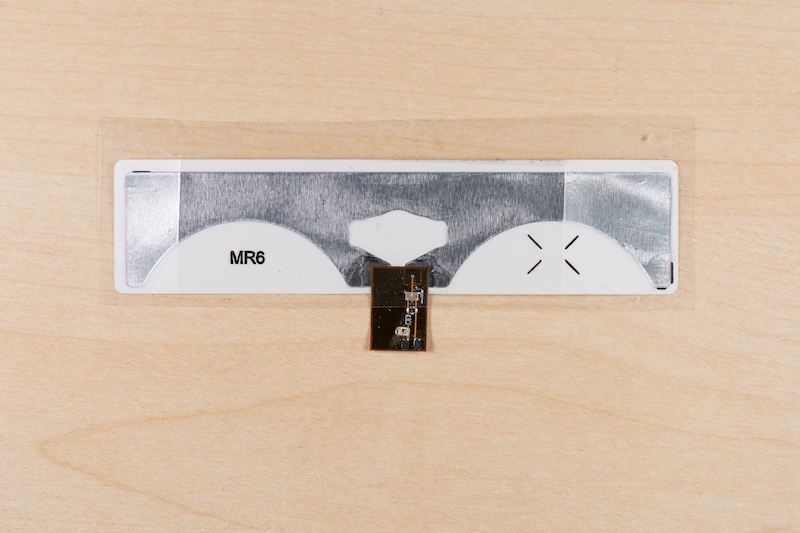- UC San Diego has developed a system that uses analog sensors with a direct interface to RFID tags, making them passive sensor devices.
- The solution includes analog to digital conversion without requiring a dedicated converter for that purpose.
Researchers at UC San Diego’s Department of Electrical and Computer Engineering have found a way to capture sensor data wirelessly with standard analog sensors, traditional commercial UHF RAIN RFID tags and readers.
The system relies on analog-digital conversion without requiring an analog-digital converter. In fact, software at the reading end makes sense of the received raw RF transmission data so that there is little additional hardware needed.
The only addition to the solution is a direct-to-RF sensor interface. It exploits the resonance of analog sensors and couples the changes in impedance to changes in the RFID tag transmission. The ZenseTag system measures those changes in impedance, and compares against a reference RFID tag response.
Lead researcher and PhD candidate Nagarjun Bhat, as well as associate professor Dinesh Bharadia, presented their research at the 22nd ACM Conference on Embedded Networked Sensor Systems (SenSys 2024) China.
Using Commercially Available, Low Cost RFID Tags
Some of the initial applications could be in agriculture for soil moisture tracking, sports and healthcare—to track conditions with wearable sensors and tags. Parking lots could serve as another potential use case said Bhat where parking space use could be detected.
Most existing approaches to passive sensing rely on analog-digital converters, which measure stimuli, record them in raw data and convert them to digital values that are readable by computers. The UC San Diego team set out looking for something simpler.
“So many of these sensors come with a lot of interfacing electronics and we wanted to get rid of all that,” Bhat said. “These types of sensor interfaces are power-hungry and battery-based systems [that] are bulky, expensive and hard to scale sustainably.”
The ZenseTag solution was aimed to use the RFID chips to directly sense stimuli without needing converters. “We wanted to know if our environment could be automated in a way that was battery-free,” he said.
Making Analog Sensing Digital
The ZenseTag design includes three features: the first is a soldered PCB which modulates the signal and measures impedance changes. It employs a Wilkinson Power Splitter between the sensor and tag for direct-to-RF impedance profiling to determine sensor resonant frequency. The second feature is a twin-tag single antenna interface with a reference and sensing tag that transmit through that antenna simultaneously. The final feature is custom software on a standard RFID reader to measure readout response.
The direct-to-RF impedance device enables the RFID tag to receive the impedance measurement (based on ratio of the sensor’s voltage and current). The output impedance then affects the channel of the 900 MHz RFID transmission.
Once it receives that backscatter signal in a specific channel, the reader can decode this digital code. In that way, Bhat said, “if you directly interface these commercial sensors to the RFID tag what ends up happening is the changes in the impedance produced by the sensor tend to morph or modulate the impedance of the tag itself.”
The software on the reader can decode the change in impedance introduced by the sensor to identify a sensor reading.
Reference Tag to Accommodate Environmental Factors
Some sensor solutions that might work in a laboratory setting, are challenged in the real world: environmental factors can alter a tag’s responding transmission. Moisture around the tag, variance in temperature, presence of a new material or people moving around the tag can affect its response.
To accommodate environmental factors, the team added an additional reference RFID tag in the same PC, using a single antenna so that two tags are interfacing with the reader from the same location. That provides some comparison of behavior between the tag attached to the sensor and the reference tag.
“In that way we are reducing any effects that are produced by objects and people moving your environment,” Bhat said.
Thus far testing has been accomplished with an Impinj RFID reader that offers about 1,000 to 1,200 tag reads per second. They then applied software for data processing.
“We are using commercially available tag,” he said. One challenge for the technology however is the need to integrate the PCB into the sticker tag.
Seeking Partnerships
“The larger picture—or the future idea—is working with a commercial RFID manufacturer to basically make these tags integrated as one single tag,” said Bhat. “We’re in fact working towards that as well, but if there is a commercial manufacturer who can help us out, that would be great.”
One of the early applications could be for soil moisture sensors that could be inserted around a field. With an enhanced RF range, the researchers say the system could be read by an RFID-enabled drone flying over a farm and detecting where soil might need watering.
Other Test Cases
This type of immediate data can also be valuable for athletes. For instance, many UC San Diego athletes engage in force plate testing as part of their training, where they jump on force plates that measure their strength, power and posture. These tests must be done at a special facility and can be expensive.
Bhat’s paper describes how RFID sensor tags could be used to bring these tests “in-house” by embedding them in shoe soles to measure an athlete’s jumping force.
A third option would be light-sensing RFID tags placed in parking garages to measure occupancy and map where and how many spaces are being used, and how many are still available. A chip could be added to the floor of every space; when a car pulls into the spot and covers the light-sensitive sensor, the tag would indicate that the spot is occupied.


